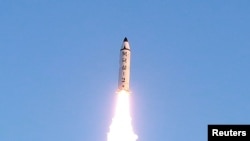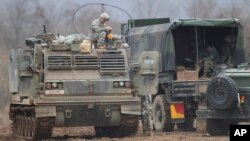North Korea fired four ballistic missiles early Monday, three of which flew 1,000 kilometers before landing in the sea within 350 kilometers of the Japanese mainland, according to South Korean and Japanese officials.
It is unlikely, however, that Monday's test was that of a long-range intercontinental ballistic missile (ICBM.)
"South Korea and the U.S. are closely analyzing at the moment. The possibility [of an ICBM test] is low, but it will require more precise analysis," said Roh Jae-chun, a public affairs officer for the South Korean military’s Joint Chiefs of Staff.
In January, North Korean leader Kim Jong Un indicated his country would soon test an ICBM. Prior to taking office, U.S. President Donald Trump tweeted a response to Kim saying "it will not happen," implying that Washington would deter Pyongyang from developing the long-range ballistic missile capability to potentially target the U.S. mainland.
Accelerated testing
In the last year, North Korea has accelerated its nuclear and ballistic weapons testing with more than 25 missile launches and two nuclear tests.
The missiles on Monday were launched from the Tongchang-ri region near the North's border with China, said the South Korean military. From this same region at its Tongchang-ri satellite facility, Pyongyang in February of 2016 launched a satellite into space using banned intercontinental ballistic missile technology.
U.S. military leaders have said in the past they believe North Korea has the ability to miniaturize a nuclear warhead to fit on a KN-08 long-range missile, although Pyongyang has not yet demonstrated this capability.
The U.S. military said Sunday it detected and tracked what it assessed was a North Korean missile launch, but added the launch did not pose a threat to North America.
Monday’s missiles flew twice as far as a test of a North Korean Musudan medium-range ballistic missile tested last month. There were no reports of damage to shipping or aircraft in the area where the missiles fell into the sea, Japanese officials said.
The Musudan has an estimated maximum range of 3,000 km that can reach targets in Japan and as far away as U.S. military bases in Guam. The closest U.S. cities to North Korea are Anchorage at 5,600 km, Honolulu at 7,000 km and Seattle at 7,900 km.
US, allies react
U.S. Strategic Command spokesman Lieutenant Colonel Martin O'Donnell said U.S. forces "remain vigilant in the face of North Korean provocations and are fully committed to working closely with our Republic of Korea and Japanese allies to maintain security."
U.S. State Department Acting Spokesperson Mark Toner condemned the missile launch and called on all states to "use every available channel and means of influence to make clear to the DPRK and its enablers that further provocations are unacceptable."
He said, “We also call on the DPRK to refrain from provocative actions and inflammatory rhetoric that threaten international peace and stability, and to make the strategic choice to fulfill its international obligations and commitments and return to serious talks. Our commitment to the defense of our allies, including the Republic of Korea and Japan, in the face of these threats, remains ironclad. We remain prepared—and will continue to take steps to increase our readiness—to defend ourselves and our allies from attack, and are prepared to use the full range of capabilities at our disposal against this growing threat.”
After meeting with his National Security Council, South Korean Prime Minister And Acting President Hwang Kyo-ahn denounced the missile tests.
“Our government strongly condemns that North Korea fired ballistic missiles once again ignoring continuous warnings from South Korea and the international community, as it is a challenge against the international community and a grave act of provocation,” said Hwang.
THAAD
The acting president also said the North’s unrestrained missile tests demonstrate the need to quickly deploy the controversial U.S. THAAD missile defense shield in South Korea.
“We need to set this defense system against North Korea's nuclear and missiles, and actively work on measures to effectively strengthen extended deterrence capability of the U.S.,” he said.
The THAAD deployment has drawn strong objections from Beijing that the advanced U.S. weapons system is an unnecessary and provocative military escalation, and that the system’s powerful radar used to track incoming missiles also poses a potential threat to China.
China is reportedly increasingly retaliating against South Korea by informally putting limits on imports and tourism.
Japanese Prime Minister Shinzo Abe also condemned the North Korea missile launch as a violation of United Nations Security Council Resolutions banning the North’s nuclear and ballistic missile program.
And he said that Monday’s missiles, which landed only 300-350 km from Japan’s Oga Peninsula in the Akita prefecture, demonstrated an increased danger to the country.
"This launch has clearly indicated that North Korea poses a new level of threat," said Abe.
Japan plans to reinforce its ballistic missile defenses and is considering buying either THAAD or building a ground-based version of the Aegis system that is currently deployed on ships in the Sea of Japan.
Joint military drills
A North Korean provocation at this time was not unexpected. Pyongyang had threatened to take "strong retaliatory measures" after South Korea and the United States began annual joint military drills last week that test their defensive readiness against possible aggression from the North.
In the meantime, Trump's national security team is reviewing a range of military options to counter the North's missile threat. The New York Times is reporting the options being discussed include missile strikes on the North's launch sites and the possibility of reintroducing nuclear weapons to the South.










